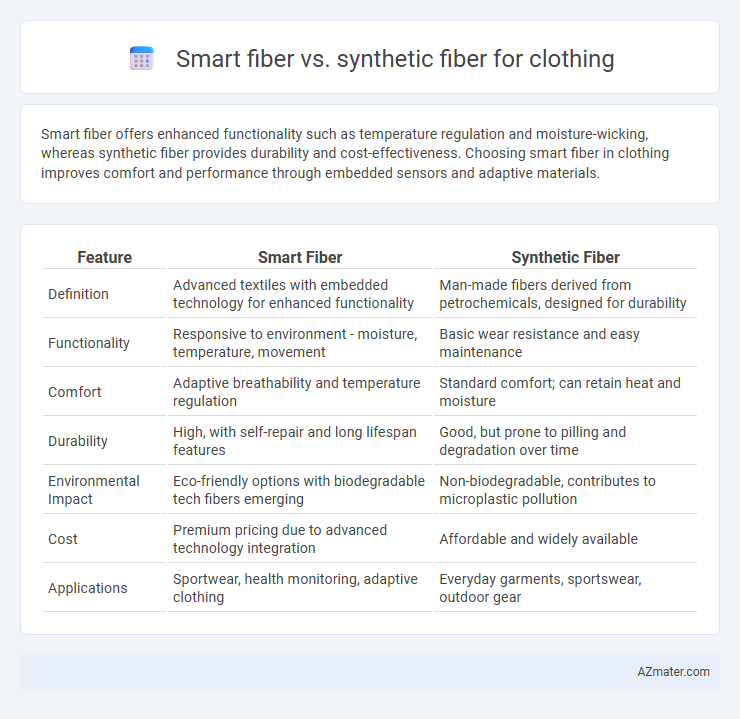Smart fiber offers enhanced functionality such as temperature regulation and moisture-wicking, whereas synthetic fiber provides durability and cost-effectiveness. Choosing smart fiber in clothing improves comfort and performance through embedded sensors and adaptive materials.
Table of Comparison
| Feature | Smart Fiber | Synthetic Fiber |
|---|---|---|
| Definition | Advanced textiles with embedded technology for enhanced functionality | Man-made fibers derived from petrochemicals, designed for durability |
| Functionality | Responsive to environment - moisture, temperature, movement | Basic wear resistance and easy maintenance |
| Comfort | Adaptive breathability and temperature regulation | Standard comfort; can retain heat and moisture |
| Durability | High, with self-repair and long lifespan features | Good, but prone to pilling and degradation over time |
| Environmental Impact | Eco-friendly options with biodegradable tech fibers emerging | Non-biodegradable, contributes to microplastic pollution |
| Cost | Premium pricing due to advanced technology integration | Affordable and widely available |
| Applications | Sportwear, health monitoring, adaptive clothing | Everyday garments, sportswear, outdoor gear |
Introduction to Smart Fibers and Synthetic Fibers
Smart fibers, embedded with sensors and responsive materials, enable clothing to adapt to environmental changes, monitor health metrics, and enhance comfort. Synthetic fibers such as polyester, nylon, and acrylic, are man-made polymers prized for durability, moisture-wicking, and wrinkle resistance in apparel manufacturing. The integration of smart fibers into textiles represents a transformative advancement beyond traditional synthetic fibers, merging technology with functional fabric performance.
Composition and Manufacturing Processes
Smart fibers incorporate advanced materials like conductive polymers, shape-memory alloys, or phase-change materials enabling responsive properties such as temperature regulation and electronic integration, typically manufactured using precision techniques like electrospinning or composite layering. Synthetic fibers such as polyester, nylon, and acrylic are derived from petrochemicals through polymerization and extrusion processes, focusing on producing durable, elasticity, and moisture-wicking textiles. The distinct composition of smart fibers integrates functional elements at a molecular level, while synthetic fibers emphasize mass production efficiency and consistent physical properties.
Key Functional Differences
Smart fibers incorporate advanced technologies such as sensors or actuators that enable responsiveness to environmental stimuli like temperature, moisture, or UV exposure, offering functionalities such as self-regulation, health monitoring, or adaptive insulation. Synthetic fibers, made from petrochemical-derived polymers like polyester or nylon, primarily provide durability, elasticity, moisture-wicking, and ease of care but lack intrinsic responsiveness or interactive capabilities. The key functional differences lie in smart fibers' ability to dynamically adjust performance based on conditions, whereas synthetic fibers offer consistent, static properties optimized for traditional clothing needs.
Performance in Comfort and Breathability
Smart fibers in clothing offer advanced moisture-wicking and temperature-regulating properties, enhancing overall comfort and breathability compared to traditional synthetic fibers. These fibers adapt to body heat and environmental conditions, providing superior ventilation and reducing sweat accumulation. Synthetic fibers, while durable and lightweight, often lack the dynamic responsiveness of smart fibers, making them less effective in maintaining consistent comfort during physical activities.
Durability and Longevity Comparison
Smart fibers, engineered with advanced materials such as carbon nanotubes or phase-change polymers, exhibit superior durability and enhanced longevity compared to traditional synthetic fibers like polyester or nylon. These smart fibers maintain structural integrity under extreme conditions, resist abrasion, and adapt to environmental changes, resulting in prolonged fabric lifespan and consistent performance. In contrast, synthetic fibers often degrade faster due to exposure to UV radiation, heat, and repeated mechanical stress, leading to reduced durability over time.
Moisture Management Capabilities
Smart fibers incorporate advanced moisture-wicking technologies that actively draw sweat away from the skin to enhance breathability and quick-drying properties. Synthetic fibers such as polyester and nylon naturally offer moisture resistance but often lack the responsive moisture management features found in smart fibers. Performance apparel leveraging smart fibers provides superior comfort by maintaining dryness and regulating temperature more effectively than traditional synthetic fabrics.
Environmental Impact and Sustainability
Smart fibers, often made from biodegradable or recycled materials, offer enhanced sustainability by reducing waste and energy consumption during production, unlike many synthetic fibers derived from petrochemicals that contribute significantly to microplastic pollution and carbon emissions. Synthetic fibers such as polyester and nylon demand high energy inputs and release non-biodegradable waste, posing long-term environmental challenges. Incorporating smart fiber technology in clothing manufacturing advances eco-friendly fashion by promoting resource efficiency, durability, and reduced environmental footprint.
Cost and Market Availability
Smart fibers, integrated with advanced technologies like sensors or conductive materials, generally come at a higher cost due to complex manufacturing processes and limited production scale, restricting their widespread market availability. Synthetic fibers, such as polyester and nylon, offer low-cost alternatives with mass production ensuring broad accessibility in the global textile market. The economic advantage of synthetic fibers heavily influences consumer preference, though smart fibers are gaining traction in niche markets demanding enhanced functionality.
Use Cases: Athletic, Everyday, and Specialized Apparel
Smart fiber enhances athletic apparel by integrating moisture-wicking, temperature regulation, and biometric monitoring capabilities, optimizing performance and comfort during intense physical activities. Synthetic fiber remains a staple in everyday clothing due to its durability, moisture resistance, and cost-effectiveness, making it suitable for casual wear and basic functional use. Specialized apparel benefits from smart fiber's adaptability for medical monitoring, military use, and environmental sensing, whereas synthetic fiber provides reliable insulation, stretch, and weather resistance in demanding conditions.
Future Trends and Innovations in Fiber Technology
Smart fibers integrate sensors and conductive materials to enable responsive clothing with capabilities like temperature regulation, health monitoring, and communication, driving the future of wearable technology. Synthetic fibers continue to evolve with bio-based polymers and advanced manufacturing techniques enhancing sustainability, durability, and comfort for mass-market apparel. Innovations such as self-healing fabrics, energy-harvesting textiles, and adaptive fibers are set to revolutionize both smart and synthetic fiber applications, merging functionality with environmental responsibility.

Infographic: Smart fiber vs Synthetic fiber for Clothing
 azmater.com
azmater.com